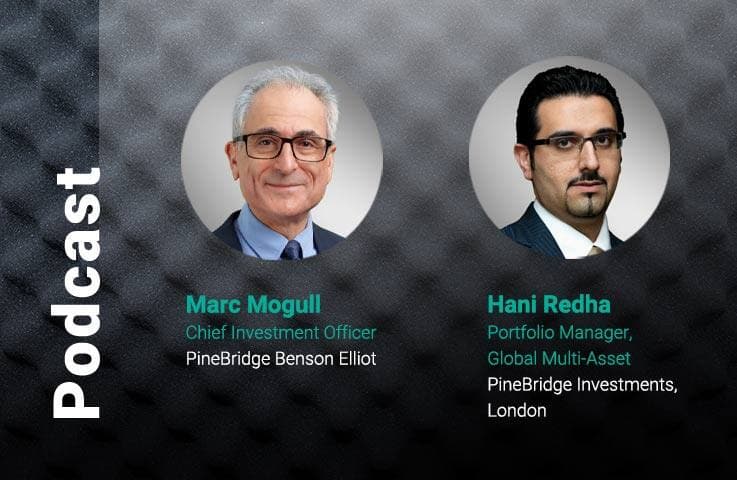Capital Market Line: Deciphering the New Regime’s New Norm

Michael J. Kelly, CFA
Global Head of Multi-Asset

Steven Lin, CFA
Portfolio Manager, Global Multi-Asset

Sunny Ng, CFA
Portfolio Manager, Global Multi-Asset

Mikhail Johaadien
Research Analyst, Global Multi-Asset

Hani Redha, CAIA
Portfolio Manager, Head of Strategy and Research for Global Multi-Asset

Peter Hu, CFA, FRM
Portfolio Manager, Global Multi-Asset

Teresa Wang
Vice President, Research Analyst, Global Multi-Asset

Following a rapid burst of Covid-related supply disruptions and resulting spikes to inflation, at long last prices are finally disinflating just as rapidly. The Fed’s traditional preferred metric of core inflation is now running at target, when viewing inflation sequentially for the last six months through November at a seasonally adjusted annual rate (SAAR) of 1.9%. Better yet, it’s no longer just goods prices deflating. Supercore inflation (Chair Powell’s new favorite, given the service nature of the US economy) is finally disinflating rapidly as well. This is particularly impressive since it’s thought to be the most labor-cost-driven portion of overall consumer inflation.
While labor markets are softening as well, they are lagging the disinflation in core services by quite a margin, suggesting either stepped-up productivity or a greater willingness by businesses to absorb remaining labor cost pressures into margins. This is much more important than whether this six-month run rate bounces a bit in the months ahead. Either way, it spells the end of policy rate hikes and allows the Fed to begin refocusing on the other portion of its dual mandate: full employment. In our eyes, the Fed appears eager to get on with it and declare “mission accomplished” after a few more months absent a meaningful bounce in inflation from today’s sequential run rate.
Goods deflation has been running in full force for some time now, reflecting the clearing of global supply chains, yet running at a greater deflationary pace than the norm for tradeable goods following China’s entrance into the World Trade Organization (WTO) in 2001. That event transitioned consumer goods prices in the US from a +1%/+1.5% trend to a new -1%/-1.5% norm. In a world of fracturing supply chains, which need more time to reveal their true long-term impact, we should be prepared for a stepped-up pace of goods inflation/deflation; perhaps it settles back in structurally at 0%/-0.5%.
Before then, we wait for goods inventory to finally clear and for new (higher) shipping costs from the Red Sea (which will affect Europe much more than the US), both adding upward but one-off pressures. At the same time, used car prices spiked when new car production was held back by a lack of semiconductors. This too is clearing, with automotive builds scheduled to ramp up in the first quarter, and inventories of electric vehicles in the US, already high, set to potentially swell, bringing prices down. New and used car prices appear to have room to fall back quite markedly. While the timing of these offsetting one-off pressures – both upward and downward – could be noisy in the short term, they will likely offset each other over 2024.
One differentiating characteristic of the regime ahead appears to be a slow evolution in structural inflation dynamics (in contrast with the rapid transitory drivers that have dominated since Covid). Structural labor shortages in the US are just one example of the potential for a long-term reacceleration in inflation if productivity doesn’t inflect higher. This shortage is primarily caused by an aging population and lower fertility rates, further exacerbated by the pandemic’s effects on early retirements and reduced immigration. To address this labor shortage, businesses could opt to keep boosting wages or to focus on productivity in this “era of innovation,” which recently has appeared to inflect higher. A key uncertainty is whether the recent inflection in productivity is a one-time occurrence, as post-Covid churn in the labor force settles down, or a lasting trend driven by productivity. We think it’s the result of churn slowing for now, with employees becoming more settled in their new firms, roles, and modes of working. However, this new world moves fast, and the trend is unlikely to sit still.
The rise of artificial intelligence (AI) is coming on much faster than expected and has the possibility to bring about structurally higher productivity. While obstacles will appear (particularly on IP grounds), its adoption curve nonetheless is expected to advance far more rapidly than the internet’s (where browsers overcame many of the same IP issues), which first required a lengthy infrastructure buildout. In contrast, AI’s growth leverages the internet’s infrastructure and is primarily driven by a much swifter software development process.
Similarly, automation is gaining prominence due to labor cost challenges and the need for efficiency in near-shoring operations. Opportunities in automation are extensive, with significant potential for upgrades in US industrial equipment and manufacturing plants. Of course, what’s different this time is the ability of these new AI features to also enhance traditional white-collar productivity. This could be a real game-changer. The degree to which the new regime will differ from the previous one will be a race between these potential productivity enhancers and long-standing structural constraints on potential growth.
What looks to be an accelerated pivot by the Fed has already eased financial conditions to such an extent that it may counteract much of the long and variable lags that continue to slow growth. If sustained, this reduces recession odds. While policy rates are now expected to pivot in the March to May timeframe, quantitative tightening (QT) has been expected to continue. Yet Fed officials are already starting to make noise about slowing its pace when the Bank Term Funding Program (BTFP) and/or the Reverse Repo Program (RRP) are wound down, or debating and articulating conditions under which it can end. Years ago, to accommodate quantitative easing (QE) fighting off the “zero bound” nature of rates, the Fed changed its operating model to manage the level of fed funds. Its procedures moved away from keeping only the fractional amount of reserves, with daily liquidity adds and drains to keep the rate at target. They moved toward operating procedures that targeted “ample” instead of “fractional” excess reserves. There was a free lunch.
Along with QE, ample reserves ushered in the free money era. Should the Fed end QT in 2024, this will not have been enough drainage to remove the thumb on the scale of structurally generous capitalization rates. We will then remain in a world still flush with too much liquidity, almost all the time, as a matter of policy. This has consequences for real interest rates (keeping them artificially low) and capitalization rates (like price/earnings ratios, keeping them artificially generous). The long journey to end the free-money era is now reaching a critical milestone. How ample is ample? At this juncture, it appears that the drainage will stop well short of removing the excess.
This reality – when combined with secularly rising fiscal deficits and reduced appetite by consumers to save (despite higher rates) in the context of a more robust investment backdrop (driven by de-globalization, the energy transition, and the necessity to go on offense in a changing business landscape) – still suggests higher real rates and less generous capitalization rates than post-financial-crisis norms, but not as much as we might have previously thought.
With the Fed’s early pivot and signs of a rebound in productivity, there are meaningful opportunities for growth in specific countries, industries, and themes, especially if the recent disinflation leads to sustained, productivity-driven supply-side growth. The near-shoring trend, fueled by trade wars and supply chain disruptions, is diversifying business supply chains away from China to countries closer to home or more politically aligned, benefiting some emerging market (EM) countries like Mexico, India, and Vietnam. Strategic industries like semiconductors and batteries are at the forefront of national security-oriented restraints.
The green energy transition also offers exposure to companies providing products and services for reaching these goals. For instance, the International Energy Agency anticipates substantial investments in energy, with an estimated annual expenditure of $4 trillion by 2050. Additionally, programs like the EU’s “Fit for ’55” and US initiatives related to infrastructure and inflation reduction are driving further investment. EMs are also poised to benefit from global climate change efforts aimed at achieving net-zero targets. At the recent COP28, funding targets were set at $1 trillion per year by 2030 to support organic investment growth in emerging markets. Annual capital flows of around $100 billion, within the context of EM’s $120 billion-$130 billion gross issuance and a GDP of approximately $24 billion (excluding China), appear significant.
In China, the new economic pragmatism which emerged since November 2022 continues, although it has slowed and is now competing more with national security. A moderate cyclical recovery still appears to be unfolding in China, although 2024’s growth rate will still be dragged down somewhat by private property construction, which will not be completely offset by stepped-up construction of public housing and urban development. Recent meetings of the Politburo and the Central Economic Work Conference (CEWC) have signaled that fiscal support is intensifying and will play the leading role, with monetary policy only in a supportive role. Most Western analysts suggest the opposite would be more successful.
Despite being relegated to a supporting role, the People’s Bank of China (PBOC) is showing signs of gradually stepped-up monetary easing, notably with the issuance of 350 billion yuan in pledged supplementary lending (PSL) to support essential projects, including affordable housing and public infrastructure. Nevertheless, additional monetary easing is vital to stabilize the housing market, a key component of consumer confidence. Delays in monetary policy adjustments risk a gradual descent into a balance sheet recession.
National security remains the top priority for Chinese officials, often overshadowing efforts to boost economic growth. This is particularly evident in China’s strategy to promote the yuan as a primary currency for trade with the Global South, which constrains their monetary policy. The swift adoption of the yuan could reduce risks related to potential US restrictions on accessing the dollar-based banking system.
Elsewhere, geopolitical risks continue to surface. Russia’s actions (and increasingly Iran’s as well) are expected to keep challenging the rules-based global order, with the seeming motto “If you can’t beat them, disrupt them.” Europe and the Middle East are seemingly entangled in prolonged proxy conflicts. Never have we seen so many black swans circling. Amidst this uncertainty, gold becomes one of the few safe-haven assets that benefit from system shocks. In addition, the de-dollarization program in the Global South, where some central banks are using their Treasury proceeds to acquire gold, should add to gold’s tailwinds.
Despite the flatness of the current Capital Market Line (CML), its reasonable level (in the mid-single-digits) is consistent in the medium term with central banks that never finished the job of rightsizing the globe’s excess liquidity. Yet significant dispersion around the line presents opportunities for more targeted investment strategies. Given the “rolling recessions” that characterized 2023 and the structural changes that likely lie ahead, while global indices are not spring-loaded for meaningful overall returns in the coming years, individual opportunities seem more poised to break away from the pack in both directions.
Capital Market Line as of 31 December 2023 (Local Currency)

Capital Market Line as of 31 December 2023 (USD View, Unhedged)

Please see Capital Market Line Endnotes. Note that the CML’s shape and positioning were determined based on the larger categories and do not reflect the subset categories of select asset classes, which are shown relative to other asset classes only.
Insights From Today’s CML
A flatter Capital Market Line (CML) with a higher level of dispersion. Our CML remains on the flat side compared to historical levels. This is partly due to cash returns pulling up the left side of the curve and allowing too much liquidity to remain in the system to continue inflating today’s asset prices, yet constraining their appreciation from these price levels. Meanwhile, the demand-side support from excess fiscal stimulus is waning. Yet with significant dispersion around the line, this landscape continues to present opportunities for more targeted investment strategies. These strategies focus on new secular growth in a period of rapid technological change or are aimed at areas emerging from rolling recessions (as catchup opportunities), even as others potentially slip into their own.
Shifting long duration to the belly of the curve. We favored a long duration posture when US real yields reached 2.5% across the curve (5% nominal at the US 10-year spot). Our long duration primarily focused on the 30- and 20-year points on the curve. Yet, as yields subsequently moved lower quite rapidly, and are already less compelling, we have eliminated our duration overweight while shifting remaining overexposures from the long end to the three- to five-year belly of the curve. While this area of the curve may have some transitory risk of a backup (with even more risk at the long end), we believe appreciation prospects are still attractive here as policy rates start coming down. As we shift away from an “Overheating” regime to one that is more balanced, bonds should provide improved hedging characteristics, even if they’re not as good as they were during the post-financial-crisis “Stall Speed” regime.
Developed market stocks look overvalued, though pockets of opportunity remain. Western equities are challenged by cresting margins, rising capital intensity (much of the outsourcing to China has either ended or is partially reversing), and tighter labor markets. These challenges, coupled with stretched equity premium levels and tightening credit conditions, signify that valuations are likely to remain a headwind. Yet some sectors still shine through. Investments related to productivity and climate change are capable of powering through a general slowdown. The healthcare sector, a 2023 laggard, also stands out as an attractive investment option on the Capital Market Line, with a history of demonstrating resilience if markets turn down while otherwise benefiting from structural tailwinds due to an aging population. Emerging market equities also present opportunities, with India offering a secular growth story and China slowly addressing its property issues, with very depressed valuations once that is behind.
Gold as a safe-haven asset amid rising geopolitical risks. In times of uncertainty and global turmoil, gold emerges as a haven asset, preserving value and offering stability. Amid escalating tensions and potential conflicts, Russia’s nuclear assistance to North Korea, proxy wars in Europe and the Middle East, and simmering economic and military rivalry between the US and China, gold has demonstrated its resilience. Fueled by the growing de-dollarization trend, central banks in the Global South are diversifying their reserves away from the US dollar and embracing gold as a safer asset.
‘Green commodities’ are structurally attractive, despite short-term headwinds. The surge in military and decarbonization investments, coupled with the need to modernize energy infrastructure, is fueling a robust demand for “green commodities.” However, a looming shortage of crucial minerals like nickel and dysprosium, essential for low-carbon technologies, is projected to materialize by 2030, potentially disrupting supply chains and driving up prices. In the near term, however, prices have been softening due to China’s economic slowdown and the broader goods recession in developed market economies.
The Fundamentals Driving Our CML
A more balanced inflationary backdrop, with shorter cycles and a more volatile macro regime, driven in part by heavy (overdone) government intervention. The previous economic regime was set against a post-balance-sheet recession backdrop, marked by consumer deleveraging, the slowest investment since before WWII, fiscal lethargy, below-target inflation, and extreme monetary policies aimed to offset these multiple drags to economic growth and to raise inflation up to target. The current regime is witnessing a consumer willing to lever up, a robust investment backdrop, and central banks fighting to bring inflation back down to target. The inherent volatility of this regime contributes to shorter economic cycles, longer recessions, and limited policy support in the face of structural inflation pressures (deglobalization, tight labor markets, climate urgency, and rising defense budgets in a world of geopolitical tensions). The true “Goldilocks” legacy of the 1980s and 1990s, with more stable growth and low inflation, took place in the context of a withdrawal of government intervention and increased market autonomy. Longer and more stable economic cycles unfolded under the leadership of Deng Xiaoping, Margaret Thatcher, and Ronald Reagan. Now, with big intermittent crises (the financial crisis, the pandemic, global warming, rising geopolitical tensions), governments are either being asked to play a more decisive role or are seizing the opportunity to do so. Yet they are not as efficient in allocating economic resources, with results likely to be more wobbly than stable. The US is now expanding its industrial policy to neutralize China’s, while central banks have taken the lead in shaping not only market, but economic outcomes. This paradigm shift, characterized by the prevalence of mega fiscal and monetary policies, has to date resulted in shorter economic cycles and heightened volatility.
From a lack of demand to a shortage of supply. While Covid-related supply disruptions are now behind us, continued tightness in labor, energy, and capacity appear to have structural roots, differing from the last cycle. Specifically, the US labor market is grappling with an enduring structural shortage, driven primarily by demographic shifts and early retirements resulting from the pandemic. Meanwhile, labor demand has been steadily increasing over the past decade, creating a significant gap between labor supply and demand that could sustain inflation. Additionally, there remains strong demand for goods and services, buoyed by healthier private sector balance sheets and real wage growth. Unlike the long-term trend of disinflation and declining rates that allowed markets to outperform nominal economics, we may now be entering a period where economies in nominal GDP terms outperform markets.
Generative AI may enhance productivity. Demographic and labor trends can be offset or magnified by technological progress as well as increased human skills and investments. Remarkably, emerging AI technologies like ChatGPT are ushering in a substantial transformation in the tech field, which could potentially result in substantial labor efficiency gains, the creation of new employment opportunities, and improved overall workforce productivity. It is estimated that AI automation may have an impact on as much as two-thirds of current jobs, with generative AI taking over a quarter of current tasks. This shift has the potential to significantly boost annual labor productivity in the US, reshaping the nature of work and spurring innovation and efficiency in businesses.
China’s decoupling from DM could fuel inflation. Geopolitical tensions have pushed Western companies to diversify supply chains away from China and closer to consumers and more politically aligned regions, like the US, Mexico, India, and Vietnam. Despite lower labor costs in many EMs, total costs could be higher than in China. In a less globalized world, companies will pay more to secure supplies, leading to significant investments and less efficiency. Overall, China’s decoupling from DM economies across key sectors will likely slow supply growth, intensifying inflation due to demographic patterns and societal shifts compared to the previous cycle.
The energy transition contributes to growth while reducing savings. The energy crisis triggered by the Russia/Ukraine conflict has accelerated the green energy transition, leading to measures such as the US Inflation Reduction Act (IRA) and the EU’s Green Deal Industrial Plan to boost investments in low-carbon energy. Increased spending on decarbonization and defense will fuel economic growth, keeping some product markets structurally tight. However, it will also contribute to reducing the global savings glut. In combination with tight monetary policy by central banks, this will tighten the supply and demand for funds and create a medium-term trend of less generous capitalization rates.
ESG 2.0. Trends may be pointing to an ESG approach (perhaps more common outside the eurozone) that emphasizes a company or industry’s improvements in ESG as the primary investment consideration, rather than cutting off industries from capital based on their current ESG conditions. This approach, which we refer to as “ESG 2.0,” encourages companies in traditionally ESG-unfriendly industries to enhance their ESG performance in order to attract investment. Many of these industries with high emissions are generating substantial cash flows and have started adopting cleaner practices. These improvements are crucial in addressing the $2.9 trillion net-zero funding gap (by our estimates). The “carrot over stick” approach of ESG 2.0 is an interesting development to keep an eye on.
Capital Market Line Endnotes
The Capital Market Line (CML) is based on PineBridge Investments’ estimates of forward-looking five-year returns and standard deviation. It is not intended to represent the return prospects of any PineBridge products, only the attractiveness of asset class indexes, compared across the capital markets. The CML quantifies several key fundamental judgments made by the Global Multi-Asset Team for each asset class, which, when combined with current pricing, results in our annualized return forecasts for each class over the next five years. The expected return for each asset class, together with our view of the risk for each asset class as defined by volatility, forms our CML. Certain statements contained herein may constitute “projections,” “forecasts,” and other “forward-looking statements” which do not reflect actual results and are based primarily upon applying a set of assumptions to certain financial information. Any opinions, projections, forecasts, and forward-looking statements presented herein are valid only as of the date of this document and are subject to change. There can be no assurance that the expected returns will be achieved over any particular time horizon. Any views represent the opinion of the investment manager and are subject to change. For illustrative purposes only. We are not soliciting or recommending any action based on this material.
About the Capital Market Line
The Capital Market Line (CML) is a tool developed and maintained by the Global Multi-Asset Team. It has served as the team’s key decision support tool in the management of our multi-asset products. In recent years, it has also been introduced to provide a common language for discussion across asset classes as part of our Investment Strategy Insights meeting. It is not intended to represent the return prospects of any PineBridge products, only the attractiveness of asset class indexes compared across the capital markets.
The CML quantifies several key fundamental judgments made by the Global Multi-Asset Team after dialogue with the specialists across the asset classes. We believe that top-down judgments regarding the fundamentals will be the largest determinants of returns over time driving the CML construction. While top-down judgments are the responsibility of the Multi-Asset Team, these judgments are influenced by the interactions and debates with our bottom-up asset class specialists, thus benefiting from PineBridge’s multi-asset class, multi-geographic platform. The models themselves are intentionally simple to focus attention and facilitate a transparent and inclusive debate on the key drivers for each asset class. These discussions result in 19 interviews focused on determining five year forecasts for over 100 fundamental metrics. When modelled and combined with current pricing, this results in our annualized expected return forecast for each asset class over the next five years. The expected return for each asset class, together with our view of forward-looking risk for each asset class as defined by volatility, forms our CML.
The slope of the CML indicates the risk/return profile of the capital markets based on how the five-year view is currently priced. In most instances, the CML slopes upward and to the right, indicating a positive expected relationship between return and risk. However, our CML has, at times, become inverted (as it did in 2007), sloping downward from the upper left to the lower right, indicating risk-seeking capital markets that were not adequately compensating investors for risk. We believe that the asset classes that lie near the line are close to fair value. Asset classes well above the line are deemed attractive (over an intermediate-term perspective) and those well below the line are deemed unattractive.
We have been utilizing this approach for over a decade and have learned that, if our judgments are reasonably accurate, asset classes will converge most of the way toward fair value in much sooner than five years. Usually, most of this convergence happens over one to three years. This matches up well with our preferred intermediate-term perspective in making multi-asset decisions.
Disclosure
Investing involves risk, including possible loss of principal. The information presented herein is for illustrative purposes only and should not be considered reflective of any particular security, strategy, or investment product. It represents a general assessment of the markets at a specific time and is not a guarantee of future performance results or market movement. This material does not constitute investment, financial, legal, tax, or other advice; investment research or a product of any research department; an offer to sell, or the solicitation of an offer to purchase any security or interest in a fund; or a recommendation for any investment product or strategy. PineBridge Investments is not soliciting or recommending any action based on information in this document. Any opinions, projections, or forward-looking statements expressed herein are solely those of the author, may differ from the views or opinions expressed by other areas of PineBridge Investments, and are only for general informational purposes as of the date indicated. Views may be based on third-party data that has not been independently verified. PineBridge Investments does not approve of or endorse any republication of this material. You are solely responsible for deciding whether any investment product or strategy is appropriate for you based upon your investment goals, financial situation and tolerance for risk.



